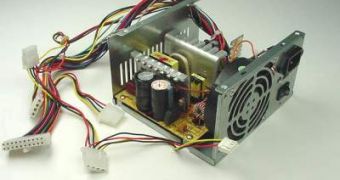What do you do when your computer starts acting up? You blame the power supply of course! Not surprisingly, the reaction is both natural and justified because the power supply is in fact one of the most important components of a personal computer and the first one to be verified in case your machine fails. Power supplies take alternating current from the outlet and convert it to direct current according to the specified requirements of the PC.
To most of us, the power supply is just another metal box with fans and lots of wires attached to the case of the PC. Most of them are able to supply three levels to voltage, 3.3 volts, 5 volts and 12 volts. The 12 volts DC outlet powers the motors and fans of the components, while the 3.3 and 5 volts one provides the digital circuits of the PC with power.
Traditional step-down voltage devices use transformers, which are relatively heavy and bulky in relation to the power supplies in our PCs today. The secret to making power supplies less heavy is in the use of a technology called Switcher, which converts alternating current with a frequency of 60 Hz into current of much higher frequency, thus converting it to DC, providing step-down voltage and current rectification.
Since power supplies first appeared there have been six types of standards, amongst which the ATX standard, the latest of all. All the cables of the ATX power supplies are standard and color-coded so that they would not be mixed up when connected to the motherboard and other components. Alternatively, ATX power supplies are Advanced Power Management compliant, meaning that PC users are given the chance to configure their computer so that power consumption is minimized.
Because they are the first to receive power when the PC is switched on, power supplies are the most likely cause of computer failure. Heating problems or 3.3 and 5 volts intermittent current absence may occasionally cause operating system failure, or PC rebooting, while a total power-supply failure usually renders all the components of the computer inoperable.
Recent development in power supplies has enabled fan control via BIOS or operating system applications. The speed at which the fan revolves is controlled according to the temperature of the power supply. Other innovations include backup power supplies, which may be switched while the primary power supply is still under use.

 14 DAY TRIAL //
14 DAY TRIAL //